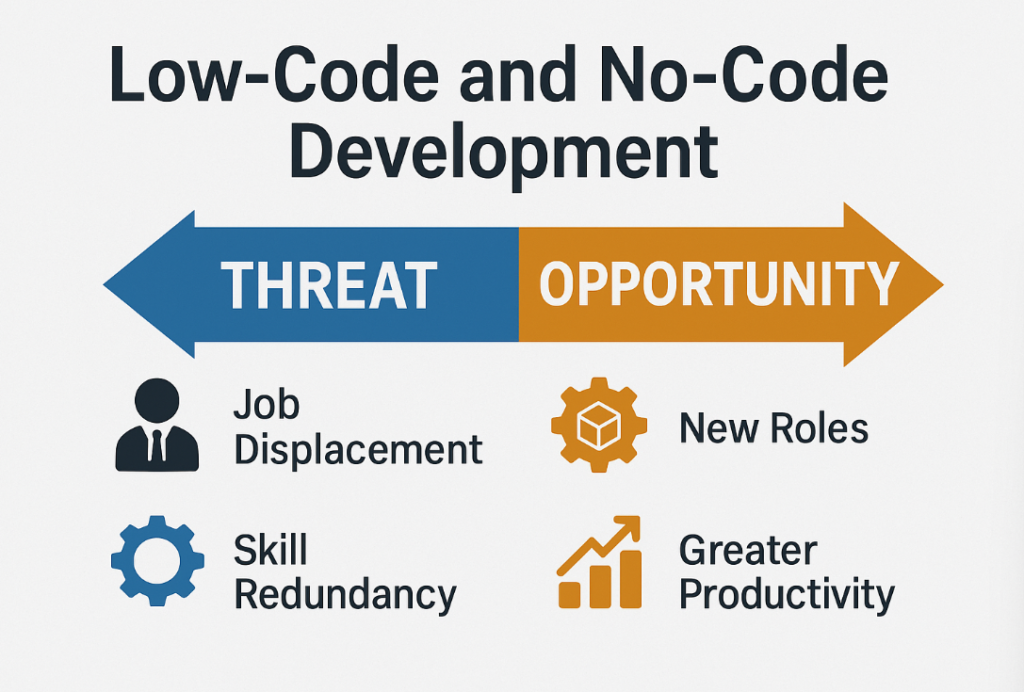
Table of Contents
- Introduction
- Understanding the Basics
- Market Trends and Growth
- Benefits of Low-Code/No-Code Platforms
- Threats Perceived by Traditional Developers
- Opportunities for Developers
- Real-World Use Cases
- Challenges and Limitations
- Future of Software Development
- Conclusion
- FAQs
Introduction
Low-code and no-code (LCNC) platforms have exploded into the tech scene, promising lightning-fast app development without the need for traditional programming skills. They’re a dream come true for business teams and a potential nightmare—or is it?—for seasoned developers. But is this movement really a threat, or is it a golden opportunity in disguise?
Let’s dive deep and find out if LCNC is the beginning of the end or the next big wave developers should ride.
Understanding the Basics
What is Low-Code Development?
Low-code development platforms allow developers to build applications using drag-and-drop tools, visual workflows, and pre-built components—while still offering the flexibility to dive into traditional coding when needed. Think of it like coding with training wheels, but you can take them off whenever you want.
What is No-Code Development?
No-code platforms take things a step further. They allow non-developers—or “citizen developers”—to build fully functional applications without writing a single line of code. It’s like using LEGO bricks to build software—intuitive, visual, and accessible.
Key Differences Between Low-Code and No-Code
| Feature | Low-Code | No-Code |
|---|---|---|
| Target Audience | Developers and IT teams | Business users |
| Coding Required | Minimal to moderate | None |
| Flexibility | High | Limited |
| Customization | Advanced | Basic to intermediate |
| Use Cases | Complex apps, integrations | Internal tools, forms, CRMs |
Market Trends and Growth
Rise of Citizen Developers
Everyone from HR reps to finance analysts are now building apps. Gartner predicts that by 2026, 80% of technology products will be built by people who aren’t technology professionals. That’s wild.
Forecasts for the LCNC Market
The LCNC market is projected to hit $65 billion by 2027. Businesses crave speed, efficiency, and control—something these platforms deliver in spades.
Platforms Dominating the Space
- Low-Code: OutSystems, Mendix, Microsoft Power Apps
- No-Code: Bubble, Webflow, Glide, Zapier, Airtable
Benefits of Low-Code/No-Code Platforms
Faster Time to Market
Why wait six months for an app when you can build a prototype in six days? LCNC platforms drastically cut development time, which means ideas go from concept to reality at warp speed.
Reduced Development Costs
Fewer developers. Faster development. Lower costs. It’s a CFO’s dream.
Empowering Business Users
With no-code, the marketing team can build its own dashboard. Sales can automate its pipeline. No need to wait on IT for every small tool.
Innovation Without IT Bottlenecks
LCNC platforms free up IT departments to focus on mission-critical systems while empowering departments to build what they need, when they need it.
Threats Perceived by Traditional Developers
Fear of Job Displacement
Let’s be real—when machines or non-coders can do your job, it’s natural to worry. But are developers really being replaced? Or is their role just evolving?
Devaluation of Coding Skills
When you’ve spent years mastering Python or Java, it stings to see someone build an app without knowing what an API is. But raw coding isn’t always the goal—solutions are.
Oversimplification of Complex Problems
No-code tools often work great—for simple workflows. But try building a complex, multi-layered enterprise platform and you’ll hit a wall fast.
Opportunities for Developers
Shifting Toward Strategic Roles
Developers can now focus on architecture, security, scalability—big-picture stuff—while letting no-code handle the basics.
Bridging the Gap Between Business and Tech
Developers are perfectly positioned to collaborate with business teams, helping translate needs into scalable tech solutions.
Customizing and Extending LCNC Solutions
LCNC platforms need devs to handle API integrations, security enhancements, backend logic, and performance optimization.
Leading Governance and Best Practices
Who sets the rules and ensures quality when business users start building apps? Developers. That’s who.

Real-World Use Cases
Startups and MVPs
LCNC is a dream for bootstrapped startups needing MVPs without burning through cash.
Enterprise-Level Workflows
Enterprises use LCNC to digitize paperwork, automate internal processes, and build customer portals—without stretching dev teams thin.
Citizen Developer Success Stories
From an office manager building a time-off tracker to a finance lead automating approvals—real people are solving real problems, fast.
Challenges and Limitations
Scalability and Security Concerns
No-code tools might struggle with handling massive traffic, complex security needs, or intricate logic.
Vendor Lock-In
Building your whole business process in one platform? Great—until they change their pricing or go down.
Limited Customization in No-Code
Need a feature that doesn’t exist on the platform? You’re stuck. Low-code offers some flexibility—no-code, not so much.
Future of Software Development
Will Developers Become Obsolete?
Nope. But they’ll need to adapt. Just like accountants adapted to Excel, developers must embrace new tools and shift focus.
The Rise of Hybrid Development Teams
Imagine developers and business users working side by side—developers focus on logic and security, users handle layout and automation. A true team sport.
Evolving Developer Skill Sets
Understanding workflows, business logic, user experience, and low-code platforms will be as important as syntax mastery.
Conclusion
Low-code and no-code development isn’t a threat—it’s a shift. Sure, it changes the developer landscape, but not in a bad way. The demand for software is sky-high, and LCNC is just helping to meet it faster. For developers willing to adapt, this is a massive opportunity to lead, guide, and innovate in ways that go beyond just writing code.
FAQs
1. Is no-code development really coding-free?
Yes, most no-code tools require zero coding. They’re designed with drag-and-drop interfaces and visual logic builders that even non-tech users can master.
2. Can low-code platforms replace full-stack developers?
Not entirely. They can handle basic to intermediate tasks, but complex applications still need full-stack expertise.
3. What skills should developers learn to stay relevant?
Focus on system architecture, cloud infrastructure, API design, low-code tools, and cross-functional collaboration.
4. Are LCNC platforms secure for enterprise applications?
Many are, but it depends on how they’re implemented. Security must be actively managed, often by experienced devs.
5. How do developers collaborate with citizen developers?
Developers can guide platform governance, build reusable components, and assist with scaling solutions built by citizen developers.


